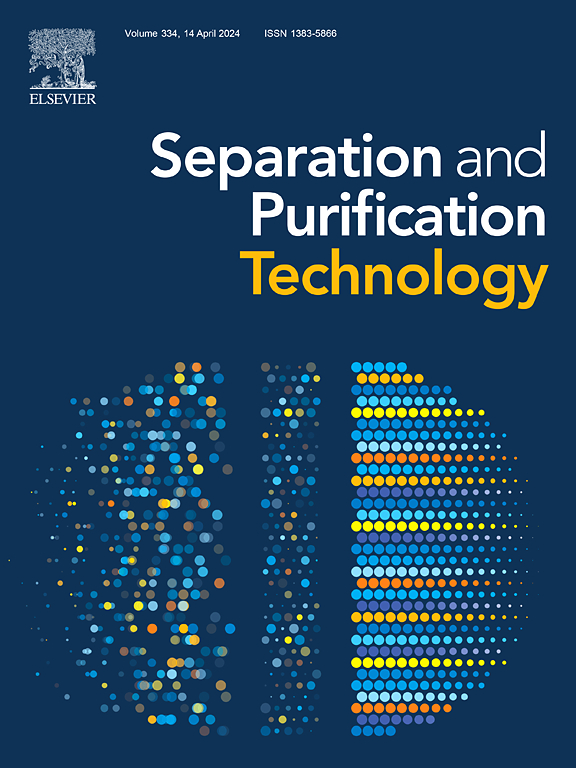Highly efficient photocatalytic degradation of ofloxacin coupling with Cr(VI) reduction by m-PDI/BiOI organic–inorganic S-scheme heterojunction catalysts
IF 9
1区 工程技术
Q1 ENGINEERING, CHEMICAL
引用次数: 0
Abstract
The combined pollution toxicity of hexavalent chromium heavy metal (Cr(VI)) and antibiotics (such as ofloxacin, OFL) is much higher than that of a single pollutant, posing a serious challenge to the ecological environment. Photocatalytic technology can achieve the removal of both single pollutants and composite pollutants. It is urgent to develop catalysts with high carrier separation efficiency and photocatalytic degradation performance. In this work, we successfully prepared m-PDI/BiOI heterojunction catalysts (mPB-3) with tight contact interfaces using the continuous ion layer adsorption and reaction method, and applied them to the synergistic removal of OFL and Cr(VI). The results showed that mPB-3 exhibited a bidirectional enhancement effect. The degradation rate of OFL reached more than 99.5 % within 40 min, the corresponding reduction efficiency of Cr(Ⅵ) reached 63.7 % at pH = 9. Furthermore, the influence of different environmental factors on the degradation process have also been clarified, indicating that mPB-3 has good stability and adaptability. The system characterization results confirmed that a S-scheme heterojunction has been formed. This can accelerate the rapid migration of electrons from m-PDI to BiOI, achieving efficient charge separation, and ultimately enhancing the photocatalytic activity. Finally, the degradation intermediate products and degradation mechanism were analyzed. This study provides a feasible solution for the design of efficient photocatalytic materials and their application in the combined pollution treatment of OFL and Cr(VI).
Environmental implication
Cr(VI) and OFL coexisting in water bodies pose significant ecological risks due to their enhanced combined toxicity. Traditional treatment techniques often struggle to effectively address such complex pollution systems. This study demonstrates that the m-PDI/BiOI heterojunction photocatalyst can efficiently synergistically remove both contaminants under environmentally relevant conditions (e.g., pH = 9), providing a practical strategy to mitigate composite pollution challenges. The S-scheme charge separation mechanism offers insights for designing advanced catalysts to tackle emerging multi-pollutant threats in aquatic ecosystems, supporting sustainable water treatment solutions.
m-PDI/BiOI有机-无机s型异质结催化剂高效光催化降解氧氟沙星偶联还原Cr(VI
六价铬重金属(Cr(VI))与抗生素(如氧氟沙星、OFL)的联合污染毒性远高于单一污染物,对生态环境构成严重挑战。光催化技术既可以实现对单一污染物的去除,也可以实现对复合污染物的去除。开发具有高载体分离效率和光催化降解性能的催化剂是当务之急。本文采用连续离子层吸附反应法成功制备了具有紧密接触界面的m-PDI/BiOI异质结催化剂(mPB-3),并将其应用于OFL和Cr(VI)的协同去除。结果表明,mPB-3具有双向增强作用。在pH = 9时,OFL的降解率在40 min内达到99.5 %以上,Cr(Ⅵ)的相应还原效率达到63.7 %。此外,还阐明了不同环境因素对其降解过程的影响,表明mPB-3具有良好的稳定性和适应性。系统表征结果证实形成了s型异质结。这可以加速电子从m-PDI向BiOI的快速迁移,实现高效的电荷分离,最终提高光催化活性。最后,对降解中间产物和降解机理进行了分析。本研究为高效光催化材料的设计及其在OFL和Cr(VI)联合污染处理中的应用提供了可行的解决方案。cr (VI)和OFL在水体中共存,其联合毒性增强,对生态环境构成重大威胁。传统的处理技术往往难以有效处理如此复杂的污染系统。这项研究表明,m-PDI/BiOI异质结光催化剂可以在环境相关条件下(例如,pH = 9)有效地协同去除这两种污染物,为减轻复合污染挑战提供了一种实用的策略。s方案电荷分离机制为设计先进的催化剂以应对水生生态系统中出现的多污染物威胁提供了见解,支持可持续的水处理解决方案。
本文章由计算机程序翻译,如有差异,请以英文原文为准。
求助全文
约1分钟内获得全文
求助全文
来源期刊

Separation and Purification Technology
工程技术-工程:化工
CiteScore
14.00
自引率
12.80%
发文量
2347
审稿时长
43 days
期刊介绍:
Separation and Purification Technology is a premier journal committed to sharing innovative methods for separation and purification in chemical and environmental engineering, encompassing both homogeneous solutions and heterogeneous mixtures. Our scope includes the separation and/or purification of liquids, vapors, and gases, as well as carbon capture and separation techniques. However, it's important to note that methods solely intended for analytical purposes are not within the scope of the journal. Additionally, disciplines such as soil science, polymer science, and metallurgy fall outside the purview of Separation and Purification Technology. Join us in advancing the field of separation and purification methods for sustainable solutions in chemical and environmental engineering.
 求助内容:
求助内容: 应助结果提醒方式:
应助结果提醒方式:


